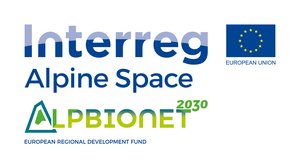Ecological networks, or "ecological connectivity", form the basis of Alpine (and global) habitat and species protection.* However, a lot of work is still required before an integrative concept for the protection of ecosystems and biodiversity in the Alps can be realized.
The ALPBIONET2030 project, under the leadership of the ALPARC network, has improved the prerequisites for the implementation of ecological interactions across the Alpine region, thereby contributing to the implementation of national biodiversity strategies. At the same time, the project made a contribution to the conservation-relevant protocols of the Alpine Convention and to the Macroregional Strategy for the Alpine Space (EUSALP), which overlaps with the Alpine Convention in significant areas but goes beyond the boundaries of the Alpine area as defined in the Convention.
The Research Institute of Wildlife Ecology (FIWI) was responsible for the management of its own workpackage for the analysis and, where necessary, improvement of Alpine wildlife management strategies as well as the fight against wildlife-related crime. Through the development of common Alpine wildlife management strategies with relevant stakeholders (for example, hunting, research, criminal investigation, nature conservation), practices which are of benefit to the ecological network were promoted and those which may be harmful shown up.
FIWI also played a key role in the development of policy options for the preparation of an Alpine-wide connectivity strategy with ecological connectivity axes within the Alps and in the direction of EUSALP. The strategy proposed inner-Alpine "Strategic Alpine Connectivity Areas" (SACA). The co-existence of human nature was also addressed and incorporated into the development of the wildlife management strategy.
* Also see Alpine Nature 2030 - Creating [ecological] connectivity for generations to come.
Duration: 1 November 2016 - 31 October 2019
FIWI activities
Open House day at Vetmeduni Vienna, 25 May 2019
Transnational workshop on wildlife mangament in Chamonix-Mont-Blac-region - 22.-23 May 2019
Transnational workshop on wildlife management in Trenta, Slovenia - 10 October 2017
Workshop on forensic methods in wildlife management, Carnia/Venzone, Italy - 12 October 2017




